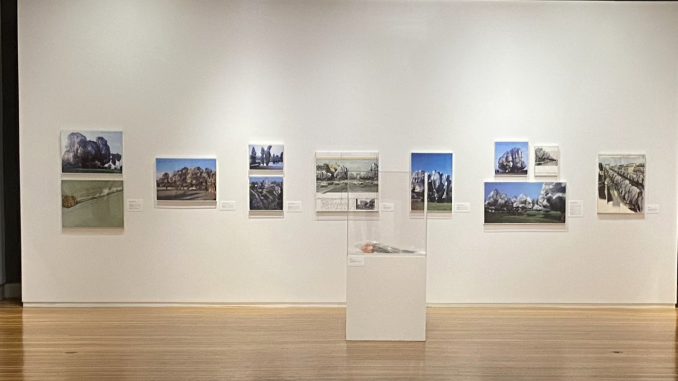
Sean McGinley (semcginley@ursinus.edu)
The Berman Museum of Art is excited to announce several new artistic exhibitions and events planned for this fall semester at Ursinus, all open and encouraged to the Ursinus community. Sanya Grace Kunicki, Communications Assistant for the Berman Museum, provided insight on the events to come.
The Berman has several scheduled events for this October, its busiest month. Two of these are related to the work of Andrea Modica, an analogue photographer whose work is currently being shown in the museum’s upper gallery in an exhibition entitled Theatrum Equorum. The series documents a veterinary center designated for horses and showcases different aspects of that type of work, such as the tools used for horses in recovery. The first of the two, occurring October 6th, involves a conversation with Modica herself hosted by Deborah Barkun, Associate Professor of Art History. The event takes place in-person at the Print Center of Philadelphia although interested students may participate online via Zoom where they will have the opportunity to “talk to [Modica] directly about her work and her creative process.” In addition to this, the Berman will host a walk-through hosted by Modica in the upper gallery later on in the month on October 26th.
The Berman also offers hands-on activities both within and outside the realm of art-making. For example, the museum will host a natural dye textile workshop on their front lawn on October 12 during the inauguration of President Robyn Hannigan. Kunicki says that for the museum, the goal of workshops like these is to get students exposed to different artistic outlets in a stress-free environment no matter their skill level. “It shouldn’t be limiting if you feel like you don’t have a skill because it’s the process itself that’s enjoyable,” she says. Kunicki also said events are an easier, more comfortable way for students to get used to the Berman and its offerings and “can be a little bit more engaging than tours for hands-on learners, and they can be a little less overwhelming as well.”
Tours and guided walkthroughs are also available whenever the museum is open. They provide students with the opportunity to have the Berman’s many exhibitions made more easily understandable for the average museum-goer. Like the events, tours were emphasized as walkthroughs in which one does not need to go in with a plethora of knowledge on art or art history. When speaking on their Immigrant Flora exhibition, for example, Kunicki stressed, “you don’t have to dive into that intellectual experience to really appreciate just how cool it looks. You can just experience it for what it is.”
The Berman isn’t just a space for the visual arts though, and Kunicki reminded the community that “The Berman always exists as a venue for anyone with club activities or just new events that they want to host. We have a huge amount of space and it’s a gorgeous building, so we’re always excited to be a venue for anyone who wants to host there.” Other events hosted by the Berman include the “Welcome Back Ursinus” concert, an upcoming music night, and yoga classes available upon registration for the community Tuesdays from 5:30-6:30 P.M. on the museum’s front lawn.
Along with these new in-person events and initiatives, the Berman has expanded its online presence dramatically. For many museums and event spaces nationwide, the COVID-19 pandemic provided a much-need notice in terms of the need for better virtual accessibility, and the Berman Museum was no different. As a result, the museum continues to work to permanently digitize the entirety of its collection, with much of it available now on the Berman’s website. Just like with the events and guided tours, virtual accessibility provides the museum with the ability to become a more welcoming and less overwhelming space for those interested in visiting. Like many others have in the past, Kunicki emphasized the “reputation of there being art snobs and you need to have this certain level of education in order to appreciate it or to understand it.” With the museum’s new online initiatives, though, she and the rest of the staff hope to combat this. She pointed to the museum’s new upcoming website as a way to make everything “much less intimidating for people to enjoy what we have to offer because they don’t have to go through the anxiety of coming into the space if that’s something that scares them.”
A renewed online presence and the continued scheduling of new events and exhibitions seems to be just the tip of the iceberg in terms of what the Berman Museum will have to offer Ursinus this upcoming school year. Other initiatives mentioned during my conversation with Kunicki included a more expansive conservation process for the campus’s outdoor sculptures as well as the addition of more blog posts and articles in the museum’s online space. She was also quick to credit the museum’s new director, Lauren McCardel, as a huge part of the impetus for these new changes. She stated that McCardel “does a really good job of analyzing the situation and finding practical solutions to it as ways to get people more engaged.”
Everything taken together, Kunicki emphasized that “We have a new brand, a new face, and a whole new digital accessibility for people.” It will be exciting to see the result of these new initiatives by the Berman Museum and its staff in the coming months. For more information on the Berman, visit https://www.ursinus.edu/berman/ or follow them on Instagram @bermanmuseum.
